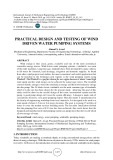
http://www.iaeme.com/IJMET/index.asp 1419 editor@iaeme.com
International Journal of Mechanical Engineering and Technology (IJMET)
Volume 10, Issue 03, March 2019, pp. 1419-1430. Article ID: IJMET_10_03_143
Available online at http://www.iaeme.com/ijmet/issues.asp?JType=IJMET&VType=10&IType=3
ISSN Print: 0976-6340 and ISSN Online: 0976-6359
© IAEME Publication Scopus Indexed
PRACTICAL DESIGN AND TESTING OF WIND
DRIVEN WATER PUMPING SYSTEMS
Ahmad S. Awad
Mechanical Engineering Department, Faculty of Engineering Technology, Al Balqa` Applied
University, Amman-Jordan, (corresponding author, Email: ahmadawwad@bau.edu.jo
ABSTRACT
Wind energy is that clean, green, available and one of the most economical
renewable energy source. Wind driven water pumping systems – windmills- are some
of the older machines. Long time ago, windmills have been developed by many cultures
to lift water for livestock, land drainage, irrigation and domestic supplies. As found
from other wind projects and studies, the most economical and useful application that
can be installed in the Jordanian arid regions is the wind pumping system using
Windmill. The Windmill is a perfect choice for our region because it doesn’t need high
wind speed and the wind torque can be achieved by using large rotors. The windmill
converts kinetic energy in wind into mechanical energy and then into hydraulic energy
into the pump. The 24 blade classic windmills are the most common type of windmills
which it is the one that been chosen for the present study. Achieving the goal of this
study could be done by the careful design of the rotor, transmission system and the
pump. A good pump design will raise the system efficiency. A design is made and all
calculations showed a very good pumping output. Then the model is manufactured in
the faculty of engineering workshop from local materials. It is designed to be used in a
wind speed of about 3.5 m/s at 8 m tower elevation. The goal is to pump 15 m3/day of
water to cover the student services building needs. The test after installation showed
that the pumping flow rate of 0.2 L/sec has been achieved; this result shows that the
designed and manufactured wind pumping system can pump more than the record which
allows storage of water.
Keyword head: wind energy, water pumping, windmills, pumping design
Cite this Article Ahmad S. Awad, Practical Design and Testing of Wind Driven Water
Pumping Systems, International Journal of Mechanical Engineering and Technology,
10(3), 2019, pp. 1419-1430.
http://www.iaeme.com/IJMET/issues.asp?JType=IJMET&VType=10&IType=3
1. INTRODUCTION
Today windmills are making a comeback thanks to rising conventional energy prices and the
threat of energy shortages. With the rise in oil prices in the early 1970s, interest in wind pumps
revived [1, 2]. However, the introduction of current multi conventional windmills in developing





















